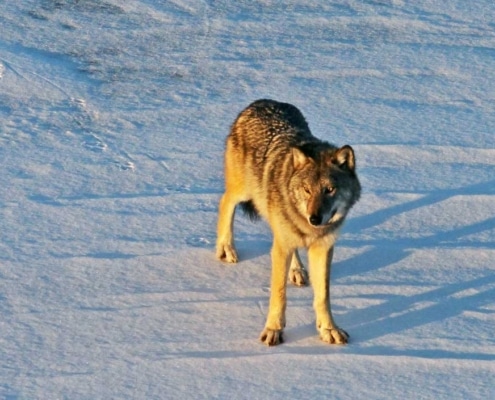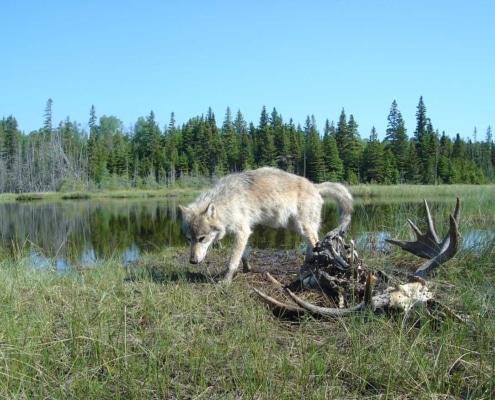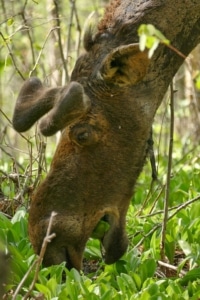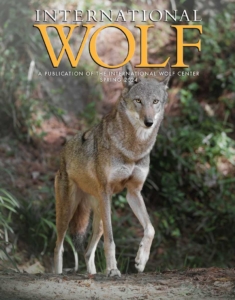By Sarah Hoy
As we get older, we may start to muse about our legacies. How have we enriched our local community or benefited society? Will any of our achievements be remembered long after we are gone? Or would the world be any dfferent if we hadn’t existed at all?
A new study led by scientists from Michigan Technological University documents the impressive legacy of a male wolf—and how his arrival on a remote archipelago one winter triggered a trophic cascade that impacted the forested ecosystem for several decades.

M93—an immigrant not related to any of the other wolves in the native Isle Royale population— quickly became the breeding male of one of three packs on Isle Royale, introducing new genes into the population. He sired 34 pups during the eight years he was breeding.
The wolf is officially known as M93, but outside of scientific journals he is affectionately referred to as “the old grey guy.” The archipelago is Isle Royale National Park, also known as Minong, situated in Lake Superior, North America. The Isle Royale wolf population has been studied since the late 1950’s and is the focus of the longest-running predator-prey study in the world. However, M93’s story begins in 1997, when he crossed a 15-mile ice bridge that temporarily connected Isle Royale to Canada.
Prior to M93’s arrival, Isle Royale wolves had been doing poorly. During the 1980s, the wolf population declined from 50 to 12 wolves, possibly due to a disease outbreak (canine parvovirus), and although the disease had disappeared by the late 1980s, the wolf population did not recover.
It was not known at the time, but the reason the wolf population struggled to recover was inbreeding depression—a phenomenon where the offspring of two closely related individuals are less likely to survive or successfully reproduce. High levels of inbreeding occurred on Isle Royale because the wolf population was largely isolated from the mainland population. Ice bridges are the only way for wolves to reach the archipelago. Such bridges do not form every year and may last only a few days. Opportunities for wolves to move between the mainland and Isle Royale have become more limited as the climate warms. High levels of inbreeding in the wolf population resulted in problems such as an unusually low number of pups born and surviving to adulthood, and spinal deformities that can be painful and limit the animals’ ability to move around.
The fate of the wolf population started to change after the arrival of M93—an immigrant who was not related to any of the other wolves in the native Isle Royale population. M93 quickly became the breeding male of one of three packs on Isle Royale, reducing inbreeding, and introducing new genes into the population. In addition to being unrelated to other wolves, M93 had another advantage—he was much larger than the native wolves. A large body can benefit wolves when it comes to defending a territory or taking down large prey, such as moose, which are roughly eight times heavier than a wolf. Those advantages made M93 a very successful breeder. He sired a total of 34 pups during the eight years he was breeding. Following M93’s arrival, the wolf population started to recover and increased back to 30 wolves. The wolves started to kill moose at a much higher rate than before—another sign that M93 had improved the health of the wolf population., M93 had essentially rescued the wolf population by alleviating the inbreeding depression.
Unfortunately, the benefits that accompanied M93’s arrival were short-lived; by 2008 they had started to fade, and an estimated 60% of the population’s gene pool was inherited from M93. After the death of M93’s original mate, he began mating with his daughter, and M93’s offspring started breeding with each other. By 2015, only two highly inbred (a father and daughter pair and half-brother and -sister) wolves were left, M183 and F193, which were unable to reproduce successfully. The future of the Isle Royale wolf population was looking very bleak. However, in 2018 the National Park Service tried to save the wolf population by translocating 19 wolves to Isle Royale from other wolf populations in the Lake Superior region.
But the story of M93’s legacy does not end with the wolf population; it next brings us to the story of another iconic animal—the moose.
Moose are the only large herbivore on Isle Royale and the main prey of wolves. In the decade following the arrival of M93, the reinvigorated wolf population preyed on moose at a higher rate than before, which caused the moose population to steadily decline. However, after 2008, when high levels of inbreeding resumed and the genetic health of the wolf population deteriorated, so did the rate at which wolves preyed on moose. That in turn allowed the moose population to increase rapidly. The deterioration of the wolves’ genetic health made them unable to perform their ecological role as the top-predator in the ecosystem.

M93’s legacy did not end with the wolf population; it affected another iconic animal—the moose. After 2008, as high levels of wolf inbreeding resumed, the rate at which wolves preyed on moose again declined. The moose population increased rapidly, and they browsed more on fir trees—another effect with long-term consequences.
M93’s Legacy Extends to the Forest
Increases in the moose population naturally led to changes in the rate at which moose browsed on trees, most notably on balsam fir. Balsam fir may be best known for their use as Christmas trees, but they are also the main food source for moose in a boreal forest ecosystem. Substantial changes in the number of moose can quickly cascade to impact forests; with their massive size—often over 800 pounds—they can consume up to 30 pounds of vegetation daily.
As the wolves’ genetic health increased following M93’s arrival, the decline in moose abundance led to a decline in browsing on fir trees. Firs began growing at rates not seen for decades. With the decrease in wolf population from 2008 to 2018, the number of moose on Isle Royale increased rapidly. That led to a moose population munching branches faster than fir trees could grow new ones. Young fir trees died or failed to grow—a change with long-term consequences. Because balsam fir is one of the most common tree species on Isle Royale, and one that provides food and shelter for a wide array of other wildlife species, moose browsing on fir has important implications for the wider Isle Royale ecosystem.
Three general lessons can be learned from M93’s legacy.
The arrival of a single individual to a small island ecosystem can affect the genetic health and fitness of an entire predator population, and those effects can flow through the prey population and onto the forest and its ecological processes.
M93’s legacy also highlights the far-reaching and profound effects genetic processes such as inbreeding can have on entire small island ecosystems. The case of these island wolves may seem unique, but many populations of large carnivores around the world are becoming increasingly small, fragmented and isolated due to factors such as habitat loss—and that makes inbreeding a major concern.

A bull moose browses on Blue-bead lillies on Isle Royale.
Current Status of Wolves on Isle Royale
Over the last five years, since wolves were translocated to Isle Royale, the wolf population has steadily increased. In March 2023, there were thought to be 31 wolves in the population. The rate at which wolves prey on moose also increased and is now back up to levels comparable to what they used to be back in the 1970s and early 1980s, before the population started to suffer from inbreeding depression. Recovery of the wolf population has naturally contributed to a decline in the number of moose on Isle Royale, which has in turn lightened browsing pressure on the forest. But it will take a long time for the plants and forests to recover.
Unfortunately, despite the recent recovery of the wolf population, concerns about inbreeding depression have not been eliminated. Ongoing concerns about inbreeding stem from the fact that eight of the 19 wolves translocated to Isle Royale were from a family of wolves that had been living on Michipicoten Island, and several of those Michipicoten wolves successfully bred. One of the first packs that formed on Isle Royale (the East Pack) was created when a brother and sister pair mated and raised a large number of pups. The mother of that brother-sister pair also raised pups on Isle Royale shortly after she was translocated from Michipicoten. In addition, one of the brothers of the two East Pack breeders established a pack at the west end of Isle Royale with a female wolf from Minnesota, and they successfully raised pups.
In other words, all the wolf pups born on Isle Royale since the translocations occurred are thought to have at least one parent from the Michipicoten family group, and they are at least as closely related as first cousins. Therefore, in just a few years, the wolves of Isle Royale have already begun to show detrimental levels of inbreeding, and the population’s genetic make-up is once again dominated by genes from just a small number of wolves.

Spring International Wolf Magazine 2024
This article was published exclusively for members of the International Wolf Center in the Spring 2024 edition of the International Wolf magazine, which is published quarterly. To learn more about membership, click here.
Sarah Hoy is an assistant professor in the College of Forest Resources and Environmental Science at Michigan Tech. She moved from Scotland to start her career in Michigan. Having earned her PhD at the University of Aberdeen, she had already studied frogs in Ecuador and goshawks in northern England. She wanted to continue a concentration on predators and prey, so “I swapped feathery things for furry things,” she said, adding—after studying wolves—that while the work is similar, the politics are not.

The International Wolf Center uses science-based education to teach and inspire the world about wolves, their ecology, and the wolf-human relationship.
